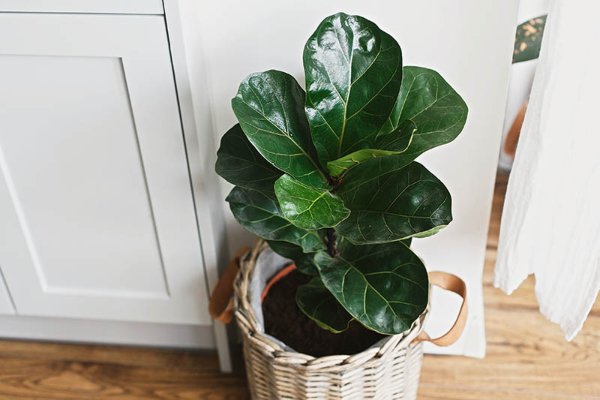Fiddle-Leaf fig has a fussy reputation when it comes to its care requirements. That’s why it is not the easiest houseplant to grow but it has lovely large leaves and tree form that makes every effort worth it. It is also a good option for someone new to gardening. These tiny trees adapt well to indoor temperatures and filtered lights and also survive less-than-ideal temperatures.
If your home has a window that gets bright morning light then you can grow this plant. Plant the fig in quality soil, and create a regular watering schedule. Then, it grows reliably and moderately quickly to between six and ten feet tall with a little mess. While it is beautiful and not that hard to care for, fiddle-leaf fig is toxic to humans and pets.
Plant Attributes
- Common Name: Fiddle-leaf fig, banjo fig
- Botanical Name: Ficus lyrata
- Family: Moraceae
- Plant Type: Broadleaf evergreen
- Mature Size: 50 ft. tall (outdoors), 10 ft. tall (indoors)
- Sun Exposure: Part Shade
- Soil Type: Loamy, medium moisture, well-draining
- Soil pH: 6 to 7
- Bloom Time: Rarely flowers outside of its native area
- Flower Color: Insignificant
- Hardiness Zone: 10-12 (USDA)
- Native Area: Tropical western Africa
- Toxicity: Toxic to people and animals
Fiddle-Leaf Fig Care
- Keep your plant near a spot that gets filtered light.
- Plant in a good quality houseplant soil and repot them once in a year.
- Do not overwater but keep the soil moderately moist.
- Adding support for the main stem is recommended.
- Rotate the pot every few days so that every part of the part gets equal sunlight.
- To promote photosynthesis, dust the leaves with a damp piece of cloth every few weeks.
- Cut the damaged or dead leaves.
Light
Fiddle-leaf figs do best when they receive bright, indirect light. That said, direct exposure to hot afternoon sun can burn the leaves. These plants adapt to low light but grow more slowly and even develop brown spots in lower lights. Insufficient light may create drainage issues to create a proper watering schedule in low-light conditions.
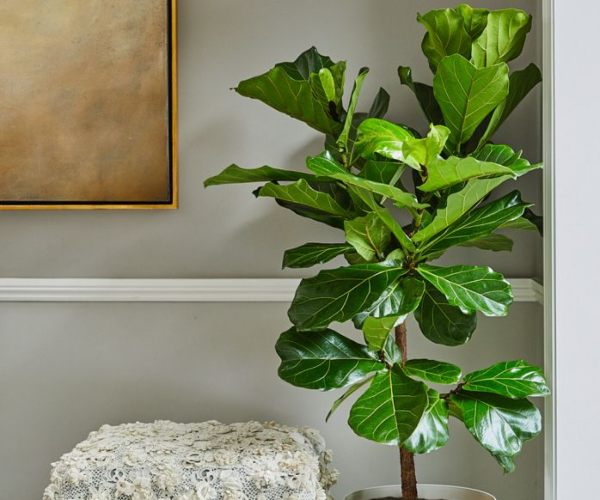
Soil
You can plant fiddle-fig leaf in any quality indoor plant potting mix as long as it is well-draining. Use peat-based soil mixed with perlite or a 50/50 combination of cactus and houseplant potting soil to allow proper drainage.
Water
This plant prefers a fair amount of moisture in the soil. If the plant doesn’t get enough amount of water then it will give you certain signs like wilting leaves, color loss, etc. However, excess watering will lead to root rot. During the growing season, water your fiddle-leaf fig only when the topmost part of the plant feels dry and water less often during winters.
These plants are highly sensitive to salt in the soil which can accumulate from clay pots, fertilizers, or treated water. To prevent salt build-up, flush the soil many times until water comes out of the bottom of the drainage holes.
Temperature and Humidity
The ideal temperature for a fiddle-leaf fig is the average household temperature between 60°F and 85°F suffice. The best humidity level should to 30 to 65 percent and leave some space around the plant for better air circulation. Misting is a great way to moisten the soil in dry winter or you can also place the pot on a tray of pebbles filled with water. Another option could be a humidifier.
Also, Read Learn to Build a Water Garden Stocked Full of Fish and Plants!
Fertilizer
Once a month feed a high-nitrogen plant food, during its growing phase. An NPK 16-5-11 is a good choice with a ratio of three parts of nitrogen and one part of phosphorous. You can also get water-soluble pellets or liquid fertilizers especially designed for fiddle-leaf figs. Water your plant regularly and do not fertilize during winter.
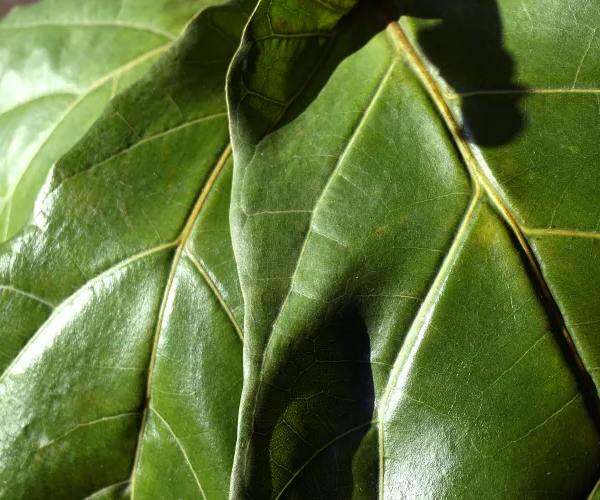
Types of Fiddle-leaf fig
The most common type of Fiddle-leaf fig is the Ficus lyrata, but there are other cultivars available:
- Ficus lyrata ‘Bambino’: This dwarf variety reaches just a few feet tall.
- Ficus lyrata ‘Compacta’: This variety grows to 5 feet tall and has smaller, denser leaves.
- Variegata Ficus lyrata: An uncommon variety with a showy mix of green and cream leaves.
Pruning
It is beneficial to occasionally prune fiddle-leaf fig. The best time to do this is in late spring or summer when the plant is in its actively growing stage. You can do so using a sturdy, sharp, hand pruner and cut at a 45-degree angle between leaf nodes. Ensure you’re not damaging a branch or the main trunk.
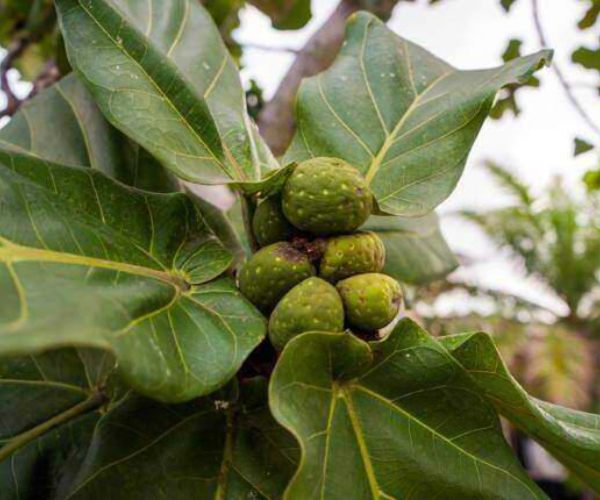
Some gardeners like a tree-like appearance with a branched canopy. Experts suggest waiting until the fiddle leaf reaches a height of 5 feet to start this process. To promote branching, top the main trunk above a leaf node. Once new branches start growing, make extra cuts for horizontal growth.
You can trim or remove dead leaves anytime. Dead leaves can simply be pulled off. You can also trim brown edges if the remaining part of the leaf remains healthy and green.
Propagate fiddle-leaf fig
It’s simple to propagate fiddle-leaf fig with stem cuttings in soil or water. There is no big difference between both mediums. If you’re planning to propagate its water, you will need a sturdy hand pruner, rooting hormone, and a clear glass container.
Propagate in Water
- Using a pair of sharp shears, cut a branch with at least three leaf nodes. The cut should be a 45-degree angle just above a node.
- Pinch off the bottom leaves just keeping one or two at the top.
- Dip the cutting in rooting hormone to cover the bottom nodes or just add a propagation accelerator to room temperature water in a clean glass jar.
- Next, put the cutting in water with nodes submerged and foliage above the water line.
- Keep the cutting in a warm spot that gets plenty of bright, indirect light.
- Change water weekly. Roots must appear in two to three weeks.
- Grow them in water until the roots get 1 to 2 inches long.
- Finally, transplant the cutting in a pot that has good drainage holes.
Propagate in Soil
For propagating in soil, start with steps 1 and 2 listed above. After that, dip the bottom part in rooting hormone and insert it into a pot filled with well-draining potting soil. A pot that is at least 6 inches in diameter with proper drainage holes is usually okay.
Make the soil firm to keep the cutting straight and cover it with a plastic bag. Keep it in a warm location with bright indirect light. After two weeks or so, check for root growth by tugging gently on the cutting. If it’s resistant, you succeed.
Potting and repotting
Repot a young fiddle-leaf fig every spring annually. Choose a sturdy container that is almost 2 inches larger in diameter than the first one. Gently loosen the plant from its existing pot, lift it out while providing support to its base, and keep it in its new pot. Fill in with potting mix around the plant.
If mature plants are too big to repot, just remove several inches of the top of the soil each spring and replace it with fresh soil.
Common Pests and Plant Diseases
The large leaves of this plant will let you know if there is any problem. Fiddle-leaf figs normally do not have any serious pests and diseases but they attract common problems like spider mites, scale insects, and fungal diseases. Look out for spots, dark patches, or white webbing on the leaves. You can get rid of them by using neem or horticultural oil. Also, you can use fungicides or pesticides.
Common problems with Fiddle-Leaf Fig
These plants are hardy and can do well indoors with a little attention. If you want yours to be at its best, just give it a little extra care and make adjustments at the first sign of a leaf problem.
Bleached Leaf
If you find light brown or bleached spots on the top of the leaves, it could be too much direct sunlight. It is called leaf sunburn or leaf scorch. You can eradicate it by pruning the leaf with sharp shears and placing the plant in a spot that has bright, filtered morning light.
Brown Spots on Leaves
Brown spots or edges are a clear indication of root rot due to overwatering. Inspect the roots and remove those that are brown or mushy. Trim the spotted leaves and repot them in fresh, dry soil, and check your watering schedule.
Temperature changes can also cause this problem. Relocate to a place with consistent temperature if needed.
Yellowing and Dropping Leaves
If you notice yellow leaves, that might be a case of bacterial infection. Try removing the affected leaves and repot them in fresh soil. Leaf drop shows either watering errors or temperature swings. Move the plant away from drafting areas and reduce watering to keep the watering moist instead of watering.
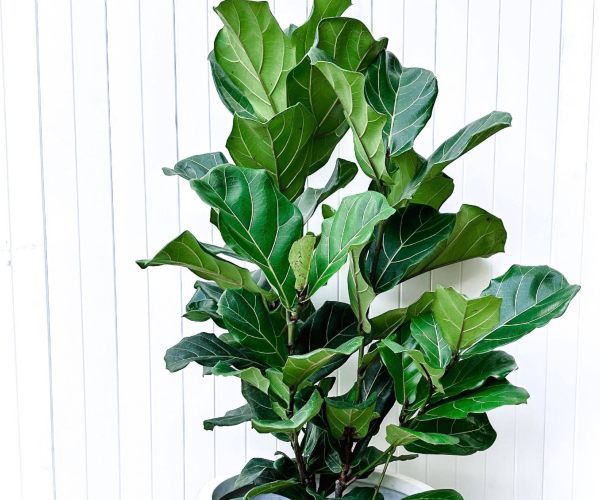
FAQs
Q: Is fiddle-leaf a low-maintenance plant?
A: Fiddle-leaf figs are not that low-maintenance and are known to be a bit finicky, though with proper care routine, this fairly hardy plant can be happy. If you give them warmth, humidity, bright, indirect light, and consistent watering, they will thrive.
Q: Is fiddle-leaf an indoor plant?
A: Fiddle leaf fig plants do well indoors. If you’re just starting with houseplants, this is a good choice for a larger, tree form that doesn’t require too much special knowledge or expertise.
Also, Read Green Guardians: These 12 Plants Can Improve Your Soil Quality
